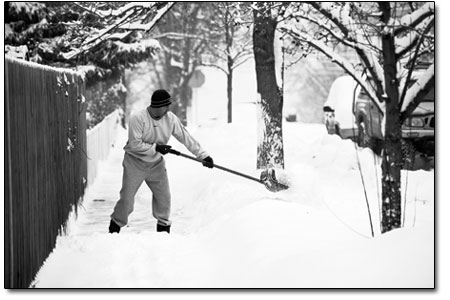|
| ||
| The art of snow removal
by Michelle Duregger Chip Huntoon climbs into the cab of his Dodge Ram plow truck every morning at 8 a.m. to the tune of the beat-box ring of his cell phone. For Huntoon, it's a cycle of another client, another roof, another walkway that needs to be uncovered, from day one of fluffy powder to heavily compacted snow weeks later. "And everyone wants you to be plowing their driveway at 6 a.m. so they can get out first," he says with a smirk. Even on the roof of three story apartments, as he and his team push snow into the caution tape below, his cell phone is crackling. "Chip's making his social calls," states Aaron Ball, Southwest Adventure Guide and part-time snow shoveling machine between clients. When the snow is on, the shovels are out, and there isn't a bulletin board in town that does not boast advertisements for snow and ice removal. Since the mega-dumps of December, the insured and uninsured companies have been vying for the right to uncover the town after each snowfall. And Huntoon's company, CH Property Services, runs with the best of them. Like many contractors, Huntoon does everything from 6-foot-deep rooftops to days of de-icing at apartment complexes. There are ice dams and roof leaks to take care of and panicking homeowners to calm. Just this month, a large 10-by 20 foot ice dam was found creeping up a leaking roof in the Cottonwoods. Its Kryptonite was a Hilti Hammer Drill, with which Huntoon demolished the ice dam's death grip. Local contractor and snow removal guru Marcus Garcia is still reeling from the epic winter of 2007-08. His company has repaired damage from ice and snow that ranged anywhere from $150 to $300,000 from last winter. Durango homeowners have apparently learned their lesson, Garcia's phone has not stopped ringing since the snow began to fall. After a storm, Huntoon's crew will take to the streets in bands of five to 25 to hold off the tides of snow that threaten to overwhelm La Plata County. The workers are climbers and former energy salesmen, guides and college students. They ski only between powder dumps and constantly have a watchful eye on the Weather Channel for more pay dirt to fall from the sky. "I've done it for 11 years, from age 16, or even earlier," Huntoon says. "I was the kid who knocked on doors for some extra cash." Now he moves snow, not with Tonka trucks but with three, heavy duty rigs (two of them fitted with plow blades), one skid-steer, six snowblowers, 100+ snow-shovels, spendy insurance coverage and two pairs of snow boots. As common as it seems, snow removal is no snow cone business. There is equipment to buy and maintain, shovels to replace, panicky clients to calm, and Durangoans to hire and put up with when powder days and hangovers call. When the snow falls, the machines - human and metal - work almost nonstop until walkways are cleared and roof tops releived. "After one full day of work last year, the snow kept falling, so I just kept working. Next thing I know it had been 72 hours," says Huntoon. Everything must keep moving despite the constant discovery of sheered bolts on snowplows, cracked snow shovels, broken welds on plow blades and constantly broken chains. All the while, the overhead is high and can be a wicked taskmaster: One plow costs $6,000-8,000, truck chains run $100 and heavy skid steer chains cost $300-$800. Even shovels chip away profits at $25 to $60 a pop. "I don't even want to name a number of shovels we went through last year, but it was a lot," notes Huntoon. In addition, a plow truck guzzles fuel at a hungry 4-10 miles per gallon while in service. Last year, workers were few and far between, but this year the masses have learned the benefits of chiseled bicepts and abs and up to $20/hour. "With the economy, everyone needs the money and is willing to do the work," says Huntoon. Between shovel-fulls, Aaron Ball notes, "I'm one of those five-jobs people." Josh Kling, the Safety-Sam of the group, ran about Hillcrest Apartments last week with fellow Southwest Adventure Guide Bill Grass, setting up spiderwebs of rope lines on snow-frosted roofs. While hooked in, the crew of five safely hucked mini avalanches off three-story roofs. Garcia also knows the routine. Between dispersing bowls of cereal to his 5-year-old daughter, Caitlin, and swigging down coffee, he got a familiar call. Soon, he and Matt King, a Pagosa Springs paramedic, were head-to-head with an 8-foot-thick ice dam, prying the shingles off a residential roof and pouring water down the tenants' walls. The distressed homeowner reported hearing loud popping noises coming from the corner of her ceiling. Her distress was justified. Snow accumulation on roofs can suffocate heating systems, and massive ice dams can cause water leaks, cut propane pipes, tear up roofing and break windows. This year, homeowners have done their best to be proactive and avoid the mess of collapsed and damaged roofs that plagued Durango in 2007. "It's been a balance between paranoia and not wanting to spend money," says Garcia. And when the snow disappears, Garcia will be found repairing the snow damage that the winter brought. The "off-season" will find Huntoon working thick of hedges and greenery, resting assured in the knowledge that Durango survived another snowy winter in part thanks to his watch. •
|


